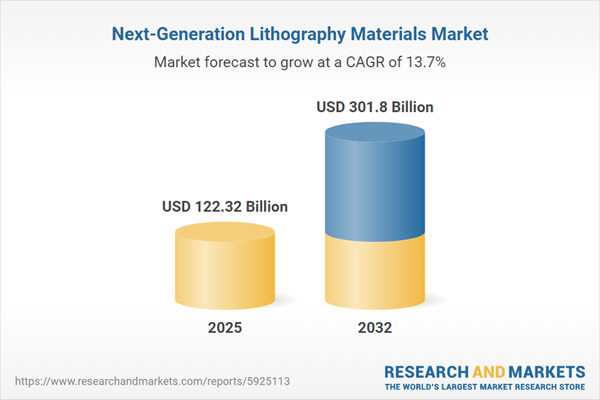Speak directly to the analyst to clarify any post sales queries you may have.
Next-generation lithography materials are catalyzing innovation across the semiconductor landscape, enabling refined device features and advanced fabrication processes. As the industry faces new challenges tied to miniaturization, material breakthroughs are vital for maintaining production quality and efficiency.
Market Snapshot: Next-Generation Lithography Materials Market
The Next-Generation Lithography Materials Market grew from USD 108.22 billion in 2024 to USD 122.32 billion in 2025. This sector is projected to expand at a CAGR of 13.67%, ultimately reaching USD 301.80 billion by 2032. Escalating demand for higher device performance, complex node architectures, and yield optimization is propelling material innovation. This growth is underpinned by technological shifts, industry collaborations, shifting policy landscapes, and increasing end-use applications ranging from photonic devices and MEMS to automotive electronics and healthcare instruments.
Scope & Segmentation of the Next-Generation Lithography Materials Market
- Material Types: Antireflective coatings for standing wave suppression, photoresists customized for various wavelengths including dry film, extreme ultraviolet, and KrF resists.
- Technologies: Directed self-assembly for nanoscale patterning, electron beam lithography for flexible prototyping, extreme ultraviolet lithography for miniaturization, ion beam lithography, multiple patterning, and nanoimprint lithography for diverse production needs.
- Applications: LEDs and OLEDs for emission efficiency, MEMS/NEMS devices requiring structural precision, photonic devices with tailored refractive indices, and semiconductor manufacturing involving integrated circuits, memory devices, and microprocessors.
- End-Use Industries: Automotive, construction, consumer electronics, defense and aerospace, healthcare, and telecommunications, each with unique material reliability and compliance requirements.
- Geographic Regions: Americas (including North America and Latin America), Europe, Middle East & Africa, and Asia-Pacific, with distinct regulatory, innovation, and manufacturing characteristics.
Key Takeaways for Senior Decision Makers
- Material advancements, especially in antireflective coatings and photoresists, are directly improving pattern fidelity and process stability, supporting next-node semiconductor transitions.
- Adoption of advanced chemistry platforms and cross-functional collaboration between materials science and engineering teams is accelerating customization and integration of new materials in manufacturing lines.
- Environmental and sustainability imperatives now shape innovation pipelines, with increased focus on low-solvent formulations and recyclable polymers to support green certification and compliance.
- Regional supply chain resilience is bolstered by localization efforts and strategic academic-industry partnerships, strengthening material sourcing and process optimization.
- Evolving application fields such as photonics, high-performance sensors, and advanced packaging are creating new demand for specialized material solutions.
Tariff Impact: United States Policy Dynamics
The 2025 introduction of new U.S. tariff policies has triggered notable changes in global material supply chains. Higher import duties on precursor chemicals and proprietary formulations have prompted fabs to diversify suppliers and bolster safety stock strategies, addressing risks to continuity. Domestic collaborations and regional raw material alliances are mitigating dependence on cross-border trade, leading to more integrated, locally resilient value chains. These policy shifts are encouraging companies to review contractual frameworks and explore nearshore alternatives to secure consistent throughput.
Methodology & Data Sources
This report utilizes a multimodal research approach that combines in-depth executive interviews, comprehensive analysis of peer-reviewed literature, and cross-referenced industry data. Expert workshops and scenario-based modeling have validated the findings to ensure applicability and alignment with current fabrication practices.
Why This Report Matters
- Informs procurement and R&D leaders about critical shifts in material science and process technologies impacting semiconductor competitiveness.
- Offers practical, region-specific guidance for navigating policy disruptions and optimizing material selection strategies.
- Supports senior management with actionable recommendations to accelerate adoption and yield improvements while addressing sustainability and regulatory objectives.
Conclusion
By mapping the latest technological, policy, and market developments, this analysis equips industry leaders to anticipate material trends and mitigate supply chain risks. Strategic investments, data-driven selection, and collaborative innovation will define ongoing success in next-generation lithography material adoption.
Additional Product Information:
- Purchase of this report includes 1 year online access with quarterly updates.
- This report can be updated on request. Please contact our Customer Experience team using the Ask a Question widget on our website.
Table of Contents
3. Executive Summary
4. Market Overview
7. Cumulative Impact of Artificial Intelligence 2025
Companies Mentioned
The companies profiled in this Next-Generation Lithography Materials market report include:- Allresist GmbH
- Avantor, Inc.
- Brewer Science, Inc.
- DJ MicroLaminates, Inc.
- Dongjin Semichem Co. Ltd.
- DuPont de Nemours, Inc.
- Entegris, Inc.
- Fujifilm Holdings Corporation
- Irresistible Materials Ltd.
- JSR Corporation by JICC-02 Co., Ltd.
- Kayaku Advanced Materials, Inc. by Nippon Kayaku Co.,Ltd.
- KemLab Inc.
- Lam Research Corporation
- Merck KGaA
- micro resist technology GmbH
- Micron Technology, Inc.
- SACHEM, INC.
- Shin-Etsu Chemical Co., Ltd.
- Sumitomo Chemical Co., Ltd.
- Tokyo Ohka Kogyo Co., Ltd.
- Toppan Printing Co., Ltd
- Weifang Xingtaike Microelectronic Materials Co., Ltd.
Table Information
| Report Attribute | Details |
|---|---|
| No. of Pages | 189 |
| Published | November 2025 |
| Forecast Period | 2025 - 2032 |
| Estimated Market Value ( USD | $ 122.32 Billion |
| Forecasted Market Value ( USD | $ 301.8 Billion |
| Compound Annual Growth Rate | 13.6% |
| Regions Covered | Global |
| No. of Companies Mentioned | 23 |









